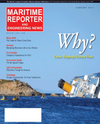
Page 29: of Maritime Reporter Magazine (February 2012)
Cruise Shipping Annual
Read this page in Pdf, Flash or Html5 edition of February 2012 Maritime Reporter Magazine
February 2012www.marinelink.com 29dergoes a lenght extension. In doing so, Meyer Werft has provided the best possible conditions in order tostand its ground successfully in the fierce international competition also in the fu-ture, and to be able to offer ships of all customary tonnages (up to 180,000 gt).The construction of cruise ships is ahighly competitive market, with much in- ternational competition. Two years ago, Meyer Werft began to restructure its strat- egy, with the aim of consolidating the company?s market position. Also, the new concept ?Continuous Improvement Process? (CIP) is being gradually imple-mented throughout the shipyard?s various sections, in the form of a continuous im-provement process. By analyzing individ- ual processes, streamlining methods canbe determined and implemented, with theaim of increasing efficiency, reducing cost, improving quality, and shortening ship throughput times. The Streamlined Shipbuilding system also necessitates streamlining of the logistics processes inthe company. All changes are based on the ?6 Rs? of logistics: the right goods at theright time, at the right place in the rightvolume, in the right quality and at the right cost.The ship development process has been implemented in the shipyard?s design and construction offices, to ensure that the work process is as productive and time- saving as it can be, even during a ship?s development phase. It also enables the needs of the production process to be ac-commodated as early as possible. The pur- chasing department subjected itself to aprocess analysis at the beginning of the year, in which two essential improvement methods were established. Ralf Sempf explaines the system: ?First of all, we need to integrate partner com- panies in a cruise ship?s design process at an earlier point in the process. This en- ables the supplier to devise plans for the various sections of the cruise ship in the early phase of the project, in consultationwith the customer and the Meyer Werft de- sign and construction office. Our partners are then better able to plan, to detect im-plementation problems at an early stage,and to develop alternative strategies. The first five pilot sections have already been defined for the new Norwegian Cruise Line ships. Secondly, we not only wish to optimize the shipyard?s processes, but also to promote the continuous improvement process together with our strategic part- ners. This involves developing the process chain together with the supplier and ex- amining the product to ascertain costs,quality, functionality and the supplier?s de- livery service, always with the goal of im- proving quality, costs and punctuality. The regional companies J&K and Wenker took part in the first projects. Joint workshops held on the premises successfully evalu- ated and prioritized productivity enhance- ment potential, which is now undergoing implementation. The advantage to our partners is that they are able to incorporate jointly developed improvements in their products and production processes. These important steps enable us to face the in- ternational competition in cruise shipbuilding together, and to maintain our market success in the future.? (L to R): Torstein Hagen, Janice Farrar-Titus of shipping company VIKING, Mr. and Mrs. Bernhard Meyer, Meyer Werft. MR Feb.12 # 4 (26-33):MR Template 2/6/2012 4:02 PM Page 29

 28
28

 30
30
